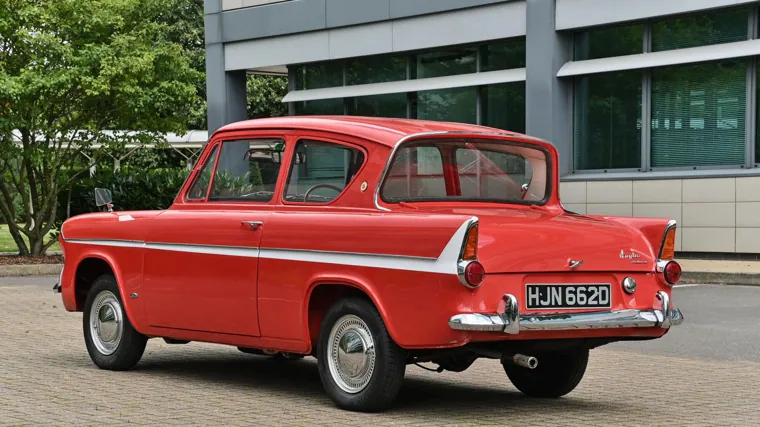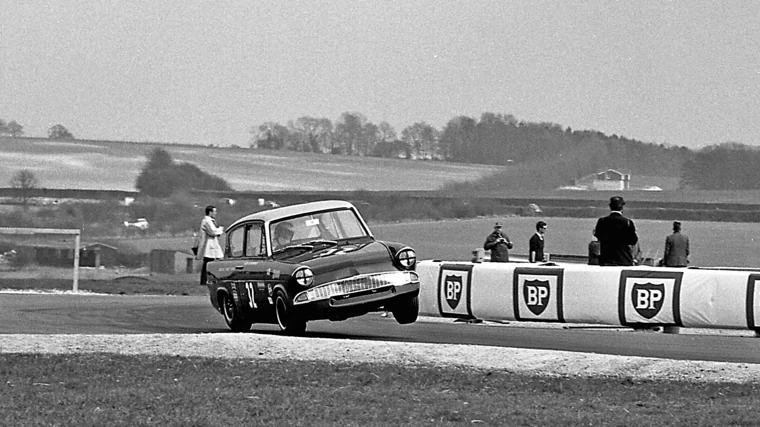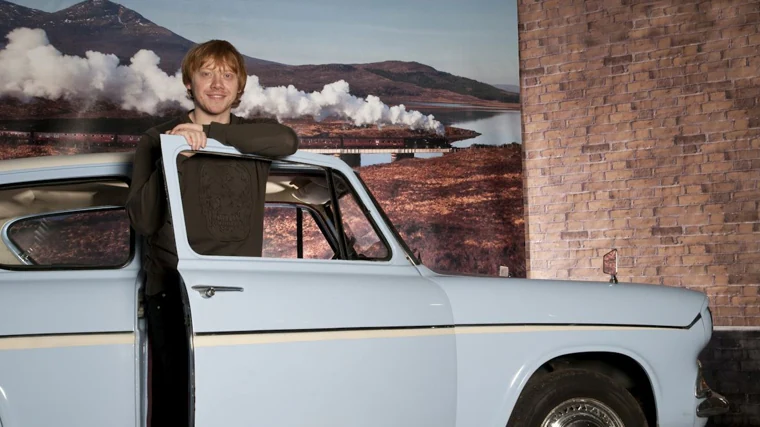In the second installment of JK Rowling’s famous saga, “Harry Potter and the Chamber of Secrets”, a small 3.91 meter car appears with a body in which the inverted rear window draws attention. It was the Ford Anglia 105E, a very popular model in the United Kingdom in the 1960s, both on the street and in rallies and circuits.
But let’s go to the beginning of the story. Without a doubt, the first generation of the Ford Anglia was not born at the best time. We are in 1939, and Hitler divides up Poland with Stalin starting World War II. Six years later, only death, ruin and misery remained of the “Thousand Year Empire”, Stalin sat with the winners, and Anglia continued its career until 1949.
That first Anglia was a small two-door car, created and manufactured by the British branch of Ford. Based on the British model there was an Anglia manufactured in Australia, between 1946 and 1948, but with different bodies. A second generation of the Anglia arrived in 1949, and it would also have its Australian variant.
The third generation, baptized as Anglia 100E, debuted in 1953. It has nothing to do with the previous two, except that it is still a small car: it now has a modern pontoon-type body (the fins are integrated), inspired by its older brother the Ford Consul, and with the chassis integrated into it.
In 1959, the fourth generation of the Anglia was presented, a very popular model in the United Kingdom.
The fourth generation
And 1959 arrives. Yes, that same year that a group called “The Quarrymen” (four guys called John, Paul, George… and Ken) played at the “Casbah Coffee Club”, the British automobile scene that was shaken by two new developments. : the Morris Mini Minor and the fourth installment of the Ford Anglia (named 105E).
Successor to the Ford Anglia 100E, the Anglia 105E, presents a totally innovative bodywork designed by the American Elwood P. Engel: the original inverted rear window attracts many glances and also mixed opinions. For its creator, the objective of this design is to improve the rear space of the vehicle, but it was also argued that it allowed the rear window to be kept clean, especially in the rain. In any case, it is clear that this aesthetic element differentiated it from the rest of the models in its segment. As for the rest of the design, the Anglia was like a small reproduction of the American models of the time, with a front dominated by a huge mesh grille, by its chrome “eyelashes” over the headlights, and a rear with fins to space fashion.

The characteristic inverted rear window that we will also see later on the Citroën Ami 6 from 1961
Initially there were only two versions available, the Standard and Deluxe sedans. Both were two-door, although, to please those buyers who wanted a four-door saloon, Ford will also launch the Prefect 107E, a combination of the body of the Ford Anglia / Prefect 100E with the mechanics of the Anglia 105E.
But let’s return to “our” Anglia 105E, and its two variants. The Standard was a simple and functional model, with a minimum of chrome details and dispensed with “luxuries” such as glove box lid, passenger sunshade, temperature gauge, or floor mats. On the contrary, the Deluxe, in addition to opening the rear windows, accentuated the American style with an optional two-tone paint, and a large amount of chrome on the outside: on the front grille, which covered the entire front, on the strip side, and in the rear pilots. The interior was also better equipped, but heating was still an option…

The interior also shows the American influence of this British
A common point between all these Anglia: its 997 cm3 and 37.5 HP engine, with overhead valves capable of reaching a maximum speed of 120 km/h, while maintaining excellent fuel consumption figures. This new 105E engine had particularly square proportions for the time. When we talk about “super square”, we mean that the diameter, 80.96 mm, is greater than the stroke, 48.4 mm. This configuration allowed for interesting preparations: many ended up installed in Formula 3 cars.
The range of three saloons remained virtually unchanged until June 1961. The Ford Prefect 107E disappeared from the catalog and Ford Thames vans were added to the new Anglia range. In September of the same year, the Ford Anglia Estate was presented, a family car that was an immediate success.
In 1962, after the announcement of the Ford Cortina Mk 1, the Ford Anglia Super was presented. It was equipped with the Cortina’s 1,198 cc 48 HP engine (thus reaching a top speed of 132 km/h), but was also distinguished by two-tone paint as standard, a distinctive side stripe, additional chrome moldings and a more luxurious interior. which, finally, included heating. Although the horsepower figures may seem low for what is now popular, we think that the weight/power ratio was very favorable and the result was quite “fun.” And so it attracted many drivers and trainers, both to race in rallies and on circuits.

Its robust engine and good behavior will attract trainers and pilots
Latest versions
In 1966 two special editions were released based on the Deluxe and Super models. These cars were available in Venetian Gold or Blue Mink metallic paint finishes with black interior trim. About 250 models were sold in each color.
All of these versions of the Anglia continued in production with relatively minor modifications until November 1967, before the launch of the Ford Escort Mk 1 in January the following year.
Pure English product
The Ford Anglia was a great success in Great Britain, and the brand’s managers thought that this success would be exportable. Thus they decided to also produce it at the Ford plant in Antwerp, Belgium, starting in 1961, under the name Anglia Sportsman (and the code 106E): this variant had the spare wheel at the rear of the car, something similar to the style “continental kit” typical of the United States, at that time. It was also exported to Holland, Luxembourg and Italy: Ford Italia redesigned the Anglia by changing most of the body panels and tilting the rear window in the opposite direction: thus the Ford Anglia Torino was born. But, outside its cradle, the Anglia was seen almost as a British eccentricity.
A movie classic
If in its original market, Great Britain, it is far from being unknown, in the rest of Europe it was not a well-known model, except to connoisseurs.
But that was before Harry Potter…. JK Rowling chose the Ford Anglia in her second novel in the series because it was the car of a close friend. And in 2002, when “Harry Potter and the Chamber of Secrets” was released in the cinema, the popularity of the car skyrocketed.
The version used in the film is a blue Anglia 105E Deluxe, whose owner is none other than Arthur Weasley, father of the hero’s best friend, Ron Weasley. A spell allows him to fly while being invisible to non-magical people (known as “Muggles”), or to have enormous capacity for occupants and luggage.

The actor Rupert Grind, Ron Weasley in the film, next to one of the Anglia used in the filming
When Harry Potter and Ron Weasley miss the Hogwarts Express, the Ford Anglia takes them on a fantastic race against time that ends with an emergency landing on the Whomping Willow. To achieve this scene six Anglia had to be used. And only two remained intact. One of them was even stolen from the parking lot of the South West Studio production company in 2005. After an anonymous call, it was found just six months later, in Cornwall, in the courtyard of a 14th century castle, in perfect condition. The other unit was acquired in 2015 by Liam Payne, a member of the One Direction group.
We said that his popularity increased when he appeared on screen. And also the price: today it can be found from 7,000 euros, but, in good condition, it already exceeds 10,000 euros. In fact, the problem will mainly be finding one in good condition. Even if 1,083,960 examples were built in England or Belgium, few have survived in good condition. It must be said that the Anglia, like many cars of the period, is greatly affected by rust, accentuated by the British climate, where most of the examples come from. And many lost their engine, robust and very attractive to tuners, which would end up in different competition cars.
#Harry #Potter #magic #Ford #Anglia #105E




